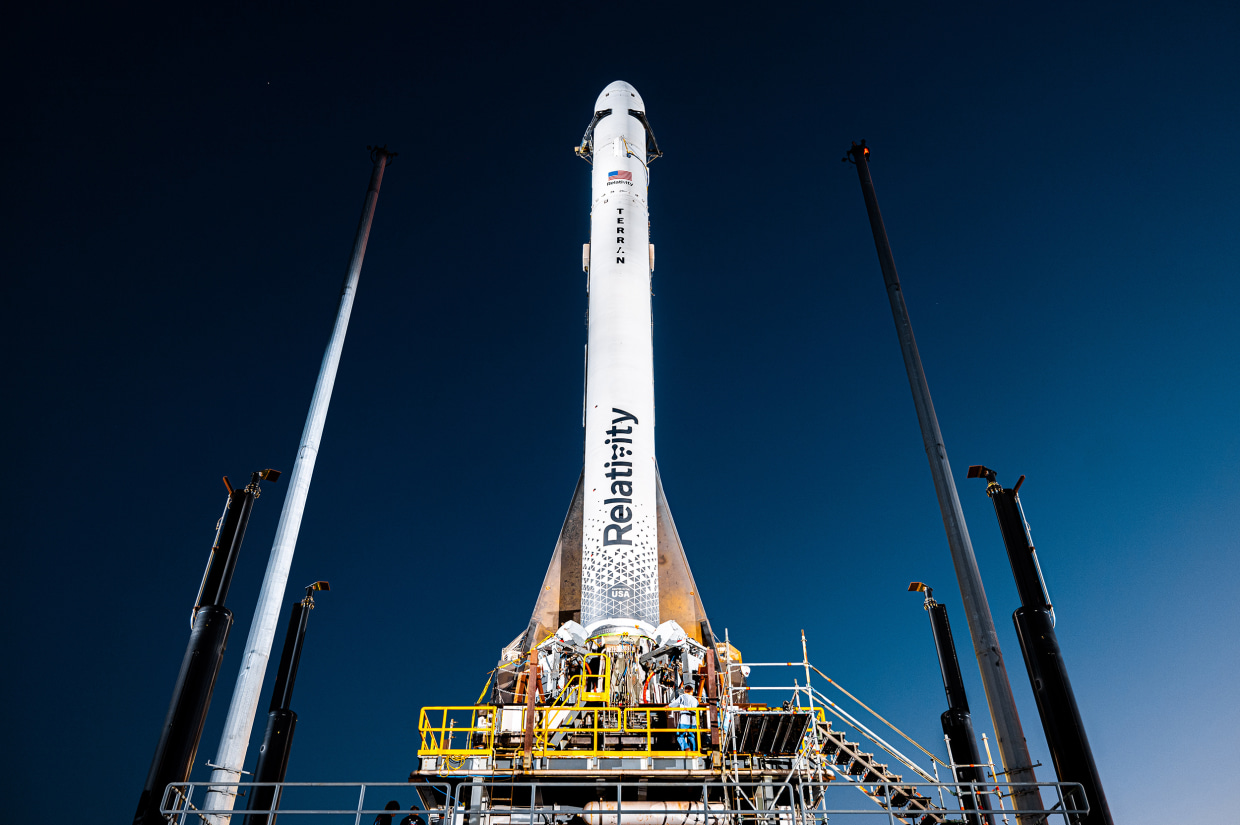A rocket that was almost entirely built in 3D is prepared to launch from Cape Canaveral in Florida and travel to low Earth orbit.
Tomorrow at 1 p.m. Eastern time, Relativity Space's Terran 1 rocket will launch for the first time, marking an important milestone for the California-based business and for advancing the use of 3D printing in the space sector. Relativity and related businesses foresee employing the technology in the future to manufacture tools, spaceships, and infrastructure in orbit, on the moon, or on Mars, using lunar and Martian dirt as construction materials in those scenarios.
Engineers at the business want to observe how Terran 1 performs on this important test flight, which they have called "Good Luck, Have Fun." Josh Brost, senior vice president, states that gathering as much data as possible and learning as much as possible from the flight are the rocket's top priorities. As it approaches a trajectory point known as, he and his coworkers will be attentively monitoring its route through the stratosphere as
About a minute after launch, the rocket will experience its "max q," or maximum dynamic pressure. According to Brost, no newly founded company has ever had its first liquid-fueled rocket reach space on its first try. Terran 1 is powered by liquid oxygen and liquid natural gas. It's quite difficult.
The Terran 1 launch vehicle is constructed differently, but it appears to be just like any other vehicle: The two-stage rocket is 7.5 feet in diameter and 110 feet tall. Just the computer system, electronics, and easily accessible components like fasteners weren't 3D printed, making up 85% of the rocket's mass, including its main structural components. (The business aims for a 95 percent success rate for upcoming rockets.) Before, other businesses employed 3D-printed items, but this is more advanced: According to Relativity Space, Terran 1 is the largest 3D-printed object ever created.
The corporation developed its own enormous 3D printers, the largest of which they called Stargate, to produce the rocket stages and their components. A robotic arm with a printer that extrudes an aluminium alloy is used in the procedure. The company's upcoming 3D printers, according to Brost, will be significantly bigger and capable of printing a single element that is 24 feet in diameter and 120 feet long.
According to Brost, there are many benefits to printing most of a rocket. Once the printer is ready, the business can combine numerous enormous, intricate parts into one, much like a massive collection of Legos. According to him, doing so lowers labour costs, makes the supply chain simpler to manage, and ultimately leads to less expensive space hardware.
Terran 1 will be used by Relativity Space to (relatively) affordably launch satellites into Earth orbit for use by other businesses and NASA. As a rival to SpaceX's Falcon 9, which has a limited cargo capacity and only reuses its first stage, the business also intends to build the Terran R, a bigger, more potent, completely reusable rocket. Relativity intends to conduct tests utilising the Terran R to launch payloads to Mars in the latter half of 2024; another firm, Impulse Space, will supply the lander.
Many businesses are investigating 3D printing uses in space. For instance, Fleet Space in Australia already manufactures portable, 3D-printed radio frequency antennas for satellites. They intend to build a whole constellation of satellites dubbed Alpha next year using printers the size of a bus. According to Flavia Tata Nardini, CEO of the firm, one benefit of 3D printing satellites and their parts is that new versions may be updated and constructed in 24 hours rather than taking months to acquire parts from the supply chain.
She predicts that 3D printing from space will follow. In ten to fifteen years, I won't need to launch satellites from here since I can make them there, according to Tata Nardini's perfect future.
The business Redwire, formerly known as Made in Space, has been utilising 3D printers aboard the International Space Station to undertake various experiments since 2016. NASA's motto is "Create it, don't take it," and the Florida-based business has adopted it, according to Rich Boling, vice president. Their bioprinter will create a prosthetic meniscus (a portion of knee cartilage) using human cells in the ISS within the next few weeks. This technique is simpler to carry out in microgravity than it is on Earth. In the future, it may be employed to heal wounds sustained by US military soldiers.
Similar to Fleet Space, Redwire envisions a future in which lunar regolith would be used to create items like astronaut housing, roadways, and landing pads. Future space manufacturing that involves mining resources from beyond our planet will bring up moral concerns regarding how those resources will be obtained and who will profit from them. But, for the time being, the biggest difficulty is determining if 3D-printed things from Earth can go to space and be useful there.
The launch attempt for tomorrow will be the second this week. On March 8, the Relativity Space crew aborted an attempt after noticing that the oxygen propellant in the rocket's second stage was warmer than anticipated.
The next launch opportunity opens at the same time on Sunday if the team is unable to launch on Saturday. There will be video from the launch attempt accessible here



